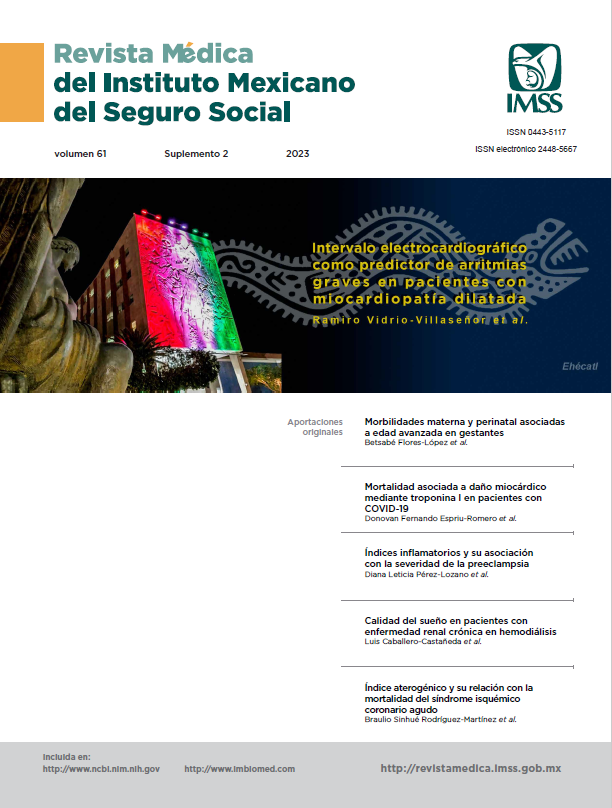Análisis de calidad de vida en pacientes con fracturas toracolumbares
##plugins.themes.themeEleven.article.main##
Palabras clave
Calidad de Vida, Fracturas Óseas, Toracolumbar, TLICS 4, Estudio de Cohorte
Resumen
Introducción: los pacientes con fracturas toracolumbares con clasificación TLICS 4 se encuentran en el límite de la fijación quirúrgica con respecto al tratamiento conservador; sin embargo, resultados en nuestro medio no son conocidos, por lo que este estudio tiene características innovadoras.
Objetivo: determinar la calidad de vida en pacientes con fracturas toracolumbares clasificación TLICS 4, mediante fijación tradicional con respecto a no fijación en un hospital de tercer nivel.
Material y métodos: estudio de cohorte prospectiva en pacientes con fracturas toracolumbares clasificación TLICS 4 mediante fijación tradicional con respecto a no fijación en población derechohabiente del Instituto Mexicano del Seguro Social (IMSS). Se aplicó el instrumento SF-12, que evaluó la calidad de vida; se buscó en los expedientes de los pacientes edad, sexo, días de hospitalización, tiempo de lesión medular. Se usó estadística descriptiva e inferencial mediante t de Student o U de Mann Whitney.
Resultados: participaron 20 pacientes y 9 (45%) tuvieron fijación tradicional. Todos los pacientes pertenecían a la clase E según las Normas Internacionales para la Clasificación Neurológica de lesiones de la médula espinal. Edad media de no fijación con 42.2 ± 12.9 y de fijación 44.9 ± 10.2; en no fijación, 6 (67%) eran varones. La puntuación de calidad de vida fue en el tratamiento conservador con 29.1 ± 0.9 y quirúrgico 28.7 ± 1.3, p < 0.462.
Conclusiones: no se observaron diferencias en la calidad de vida en pacientes con fracturas toracolumbares clasificación TLICS 4 mediante fijación tradicional y no fijación.
Referencias
De la Torre González D, Góngora López J. Fracturas vertebrales toraco lumbares. TRAUMA, 2003;6:44-48. Disponible en: https://www.medigraphic.com/pdfs/trauma/tm-2003/tm032b.pdf.
Llado A. Rothman-Simeone. Columna vertebral. Rev Ortop Traumatol 2004;48:157-8. doi: 10.1016/s1888-4415(04)76188-3.
Briem D, Behechtnejad A, Ouchmaev A, et al. Pain regulation and health-related quality of life after thoracolumbar fractures of the spine. Eur Spine J. 2007;16(11):1925-33. doi: 10.1007/s00586-007-0395-x.
Kanna RM, Raja DC, Shetty AP, Rajasekaran S. Thoracolumbar Fracture Dislocations Without Spinal Cord Injury: Classification and Principles of Management. Global Spine J. 2021 Jan;11(1):63-70. doi: 10.1177/2192568219890568.
Viswanathan V, Kanna R. Management of thoracolumbar fractures in adults: Current algorithm. International Journal of Spine. 2019;4:1-10. Disponible en: https://www.semanticscholar.org/paper/Management-Of-Thoracolumbar-Fractures-In-Adults%3A-Viswanathan-Kanna/8e9ea6ea59f59356fb0c71faaa6d5229c0648bf6.
Kepler CK, Vaccaro AR, Koerner JD, et al. Reliability analysis of the AO spine thoracolumbar spine injury classification system by a worldwide group of naive spinal surgeon. Eur Spine J. 2015; 25:1082-6. doi: 10.1055/s-0035-1554203.
Nath HD, Barua KK, Rahman A, et al. Management of Thoracolumbar Fracture with Posterior Decompression with Fusion and Fixation by Pedicle Screw and Rod—Our Experience. Indian J Neurotrauma 2019;16:38-44. doi: 10.1055/s-0039-1700376.
Singh K, Kim D, Vaccaro A. Lesiones vertebrales toráxicas y lumbares. Capítulo 69. En: Rothman-Simeone vol 2. 5a ed. Elsevier; 2007.
Chapman JR, Agel J, Jurkovich GJ, Bellabarba C. Lesiones toracolumbares de la flexión-distracción: morbosidad asociada y resultados neurológicos. Espina Dorsal. 2008;33:648-57. Disponible en: https://www.scielo.br/j/coluna/a/DQFzvRn7VxsyCjRHTv7Tmsf/?lang=es&format=pdf.
Kotb M, Kotb A, Anwar H, Kattab MF. Thoracolumbar Fractures, Posterior versus Anterior Management: A Case Series and Literature Review. EgySpineJ. 2019;30:12-22. doi: 10.21608/esj.2019.7091.1087.
Gomleksiz C, Egemen E, Senturk S, et al. Thoracolumbar Fractures: A Review of Classifications and Surgical Methods. J Spine. 2015; 4: 1-6. Disponible en: https://www.hilarispublisher.com/open-access/thoracolumbar-fractures-a-review-of-classifications-and-surgical-methods-2165-7939-1000250.pdf.
Smith HE, Anderson DG, Vaccaro AR, et al. Anatomy, Biomechanics, and Classification of Thoracolumbar Injuries. Seminars in Spine Surgery. 2010;22:2-7. doi: 10.1053/j.semss.2009.10.001.
Wood K, Buttermann G, Mehbod A, et al. Operative compared with nonoperative treatment of a thoracolumbar burst fracture without neurological deficit. A prospective, randomized study. J Bone Joint Surg Am. 2003;85-A:773-81. doi: 10.1016/j.spinee.2012.08.082.
Roberts T, Garret L, Cepela D. Classifications In Brief: American Spinal Injury Association (ASIA) Impairment Scale. Clinical Orthopaedics and Related Research. 2017;75:1499-504. doi: 10.1007/s11999-016-5133-4.
Bazán PL, Borri AE, Tores PU, et al. Clasificación de las fracturas toracolumbares: comparación entre las clasificaciones de AO y Vaccaro. Coluna/Columna. 2010;9(2):165-70.
Park C, Kim S, LeeT, et al. Clinical relevance and validity Of TLICS system for thoracolumbar spine injury. Nature Scientific Reports. 2020.
doi: 10.1038/s41598-020-76473-9.
Rhinn J, Anderson D, Harris E, et al. A review of the TLICS system: a novel, user-friendly thoracolumbar trauma classification system. Acta Orthopaedica. 2008;79(4):461-6. doi: 10.1080/17453670710015436.
Esclarín-de Ruz A. Lesión medular traumática. Valoración y manejo integral. Medicine - Programa de Formación Médica Continuada Acreditado. 2019;12:4387-400. doi: 10.1016/j.med.2019.03.020.
Mittal S, Ifthekar S, Ahuja K, et al. Outcomes of Thoracolumbar Fracture-Dislocation Managed by Short-Segment and Long-Segment Posterior Fixation: A Single-Center Retrospective Study. Int J Spine Surg. 2021;15(1):55-61. doi: 10.14444/8006.
Dai LY. Remodeling of the spinal canal after thoracolumbar burst fractures. Clin Orthop Relat Res. 2001;382:119-23. doi: 10.1097/00003086-200101000-00018.
Pérez Estudillo CA, Sánchez Alonso D, López Meraz MA et al. Aplicaciones terapéuticas para la lesión de médula espinal. Revista eNeurobiología. 2018;9:1-16. doi: 10.25009/eb.v9i21.2534.
American Spinal Injury Association. Normas Internacionales para la Clasificación Neurológica de las Lesiones de la Médula Espinal (ISNCSCI). Edición revisada 2019. ASIA; 2019; 0-0. Disponible en: https://asia-spinalinjury.org/product/international-standards-for-neurological-classification-of-spinal-cord-injury-isncsci-revised-2019-spanish-language-edition/
Rutges JP, Oner FC, Leenen LP. Timing of thoracic and lumbar fracture fixation in spinal injuries: a systematic review of neurological and clinical outcome. Eur Spine J, 2007;16:579-87. doi: 10.1007/s00586-006-0224-7.
Öner F, Wood KB, Smith JS, et al. Therapeutic decision making in thoracolumbar spine trauma. Spine. 2010;35 Suppl: S235-44. doi: 10.1097/brs.0b013e3181f32734.
Gnanenthiran SR, Adie S, Harris IA. Nonoperative versus operative treatment for thoracolumbar burst fractures without neurologic deficit: a meta-analysis. Clin Orthop Relat Res. 2012;470:567-77. doi: 10.1007/s11999-011-2157-7.


